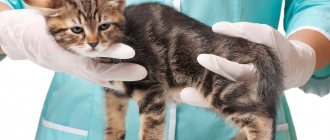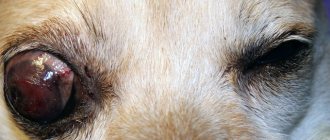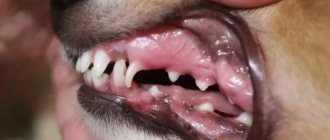General information about the disease
The cornea performs protective functions. It does not allow the external environment to influence the eyeball. The structure of this organ has three layers:
- thin epithelium;
- stroma, which is the core;
- Descemet's membrane.
At the initial stage, the epithelial layer is damaged. Access is opened for microbes and bacteria to the stroma. If the disease is detected at the stage of destruction of the epithelium, you can get rid of it in a conservative way. When the lesion spreads to the stroma, surgical intervention is usually used.
Blood vessels on the cornea
In healthy eyes, blood vessels are not visible. When an ulcer forms, elements of the blood flow network become noticeable. This symptom indicates that the ulcerative lesion has invaded the deep layers of the organ.
Blood vessels originating in the sclera rush to the site of ulcer formation. This reduces visual acuity. Even after successful treatment, this symptom persists for a certain time.
Prevention of keratitis in cats
If we talk about infectious keratitis
x, then we can say that the most important thing for prevention is to avoid contact with sick animals or newly acquired ones. All animals entering your home must undergo quarantine, be treated for ectoparasites and endoparasites, and also be examined by a therapist and vaccinated.
If we talk about breed characteristics
, then here animals with brachiocephalic syndrome (Persian, exotic, British, Scottish and others) must undergo special control. If you identify the problems described above, you should immediately contact the clinic and have your pet’s eyes examined.
For bacterial and fungal diseases
You need to go to the clinic in a timely manner. The most striking symptom is profuse purulent discharge from the eyes and squinting.
For the prevention of traumatic keratitis
It is necessary to remove all chemical objects from places accessible to the cat to prevent burns to the cornea and chemicals getting into the eyes. If the cat does come into contact with chemicals, you need to rinse your eyes with copious amounts of saline and go to the clinic as soon as possible, since deep lesions of the cornea can lead to loss of the eye.
For traumatic lesions of physical origin
it is necessary to restrain the animal so that it cannot injure the eye: either put on a collar, or pick it up and, if possible, take it to the clinic as quickly as possible, since deep injuries may require surgical treatment and lead to loss of the eye.
If it is impossible to restrict the cat from contact with other animals, most often it concerns those who live in private homes or go to the country, it is necessary to examine the animal several times a week to exclude visible problems. If changes are detected, you should see a specialist.
Keratitis can often occur in animals that are exhausted and sick for a long time, as well as in those taking hormonal medications for a long time. Such pets should be examined regularly to rule out damage and see a specialist as soon as possible after eye problems are identified.
Author of the article: veterinary ophthalmologist Mamedkuliev Andrey Konstantinovich
Types of disease
Veterinarians define three types of corneal ulcers:
- average,
- deep,
- perforative.
In the middle stage, the affected area covers the stroma. A large volume of intercellular fluid penetrates into its tissues. The cornea becomes cloudy, and partial loss of vision is observed. In the deep stage, Descemet's membrane is damaged. At this stage, the eyeball is filled with intercellular fluid. A perforated ulcer is diagnosed very rarely. If the disease is detected at this stage, the visual organ must be removed.
Causes and symptoms
Keratitis is swelling and irritation of the cornea, the protective layer of the eyeball. The condition can dry out the cornea, and for this reason it is also known as “dry eye.”
The causes of keratitis have not been precisely determined, but several factors may be suspected in its formation:
- feline herpes virus;
- a foreign object that injures the cornea;
- eye injuries;
- eye infection
The disease may be more common in certain breeds of cats, so many experts believe that genetic factors are a greater contributor to its occurrence.
Most often, in almost 100% of cases, this disease is acquired in a cat.
Keratitis is a condition that is manifested by the presence of several symptoms, such as:
- excessive redness;
- discharge - clear or purulent, having the consistency of mucus;
- frequent squinting;
- sensitivity to light, the cat will look for darker places in the house;
- facial irritation;
- rubbing the eyes;
- elevated temperature;
- sneezing;
- clouding of the corneal tissue;
- nasal discharge;
- lethargy.
Causes of the disease
Disease of the corneal tissue can occur for various reasons. Knowing the provoking factors will help prevent the appearance of ulcers and take timely measures.
Eye injuries
The cause of the ulcer can be injury received during a fight, falling, or causing microscopic scratches on the protective layer. With strong immunity, such wounds heal in cats without any consequences. But if they are received during a weakening of the body, pathogenic bacteria can actively multiply and create an infectious focus.
The most common causes of injuries include:
- injury to the cornea with a claw while washing;
- getting hit by a foreign object while walking;
- chemical burns from household chemicals and fertilizers.
At the first stage of the appearance of an infectious focus, serous conjunctivitis and keratitis develop. Lack of treatment causes the development of ulcers.
Penetration of infection
The cause of a corneal ulcer may be an infection that has penetrated the tissue due to damage to the epithelium and lack of protection. Infection with pathogenic microorganisms in the absence of vaccination is possible.
Corneal ulcers are rarely diagnosed as an independent disease. For the most part, it is a complication of existing inflammation in the body.
Genetic predisposition
There are cat breeds whose representatives have a hereditary predisposition to this ophthalmological pathology. Breeds at risk include:
- British,
- Himalayan,
- exotic,
- Persian,
- Scottish.
Predisposition to the disease is due to the specificity of incomplete closure of the eyes due to the structural features of the skull. It should also be taken into account that this disease is diagnosed more often in older animals than in young pets.
Pathologies of the eyelids and eyes
Provoking factors include various pathologies of the visual organs:
- blepharitis;
- inversion of the eyelids;
- entropy;
- trichiasis;
- ectopia.
Forms of violation
Feline keratitis can take two forms:
- Spicy.
- Chronic.
The acute form of the disease develops rapidly. With this type of pathology, the patient's condition worsens within a few hours. It is typical for acute keratitis to manifest itself against the background of existing ophthalmological problems, intoxication, injuries to the visual organ, and the presence of foreign objects in the eyeballs. In case of untimely treatment, acute keratitis often becomes chronic.
Chronic keratitis, also called vascular or pigmentary, is characterized by a long development - from several weeks to 2-3 months or a whole year. This form of disorder is provoked by long-term purulent conjunctivitis, dry eye syndrome, chronic bacterial or viral infections. Sometimes the cause of the disease in cats is helminthic infestations.
Keratitis in animals can also be local and total. In the first case, individual areas of the cornea are affected, and small cloudy spots are found in the eye. If there is a total form of the disease, the entire surface of the cornea is covered by the inflammatory process. The consequences of this are a severe decrease in visual acuity and even blindness.
Main symptoms of the disease
The symptoms of corneal ulcers are poorly identified; it is difficult even for an experienced specialist to recognize the disease at an early stage. Obvious signs appear only during periods of exacerbation; an accurate diagnosis can be established by an ophthalmological examination. The most typical symptoms include:
- increased tearfulness, moisture, shine in the eyes;
- clouding of the cornea, redness of the proteins;
- inappropriate behavior, squinting of eyes, rubbing with paws.
Symptoms of a corneal ulcer are similar to those of conjunctivitis. But this disease usually affects one eye.
Ulcerative keratitis
This form of the disease can be infectious or non-infectious. The latter includes mechanical damage to the organs of vision.
Most often, ulcerative keratitis occurs in brachycephalic breeds (Persians, Exotics, Himalayans). This is due to the specific structure of the skull and the prominence of the eyes. Therefore, the chance of injury in these animals is much higher than in other breeds. In addition, such cats have a deficiency in the production of tear fluid; the stroma has a special structure. This is why ophthalmological problems arise.
With ulcerative keratitis in cats, there is no discomfort, this is due to the lack of sensitivity of the corneal part of the eye. If there is no infection, the ophthalmological problem is completely resolved, only the eye remains slightly cloudy.
The disease can develop against the background of certain pathologies:
- hypovitaminosis;
- diabetes mellitus;
- in case of metabolic disorders;
- chronic renal failure.
The ulcerative form is treated by eliminating the causes that led to the inflammatory process and using the following solutions:
- rivanol – 1%;
- furatsilina – 1:5000;
- boric acid – 3%.
Therapeutic treatment
The conservative complex includes:
- eye drops with antibacterial properties;
- antibacterial ointments;
- painkillers, sedatives;
- wearing a protective collar.
Drops of a range of antibiotics are instilled every 4 hours. You can replace them with ointments that retain the effect longer. The treatment complex includes Atropine, which relieves spasms and pain symptoms. It should be taken into account that this drug dilates the pupils and cats under its influence will experience discomfort from bright light.
Diagnosis and treatment of keratitis
The diagnosis of the disease is established on the basis of characteristic clinical symptoms.
In order to clarify the etiological factor, it is necessary to conduct various general and laboratory studies, as well as a thorough analysis of anamnestic data, since most keratitis are always symptoms of a general disease. Biomicroscopy using a slit lamp helps establish the diagnosis. Defects in the corneal epithelium are easily detected after instillation of a 1% fluorescein solution.
Treatment of keratitis in dogs and cats
Treatment depends on the cause of keratitis, the depth of damage to the cornea, and the severity of the disease, which is determined by a veterinary ophthalmologist. For keratitis, medications are used in the form of eye drops, ointments, some drugs are administered as injections under the conjunctiva, into the postorbital space. Tablet forms, intramuscular, subcutaneous and intravenous injections are recommended.
In the treatment of viral keratitis, antiviral therapy is used: drugs containing interferon and interferon stimulators. For herpetic keratitis - drops, ointments, tablets containing acyclovir.
For bacterial keratitis, antibiotics and broad-spectrum sulfonamide drugs are prescribed, and upon receipt of the results of a bacteriological study, taking into account the sensitivity of the pathogen to the antibiotic.
The treatment of allergic keratitis requires the use of antiallergic drugs, both local and general. Products are used to promote corneal epithelization, usually in the form of gels and ointments.
If there is a threat of corneal perforation, a pronounced decrease in vision as a result of cicatricial changes, a cosmetic defect, etc., corneal plastic surgery is performed in varying volumes.
Prevention of keratitis consists of timely and adequate treatment of blepharitis, conjunctivitis and dacryocystitis, general diseases of the body that contribute to corneal disease, and the prevention of eye injuries.











